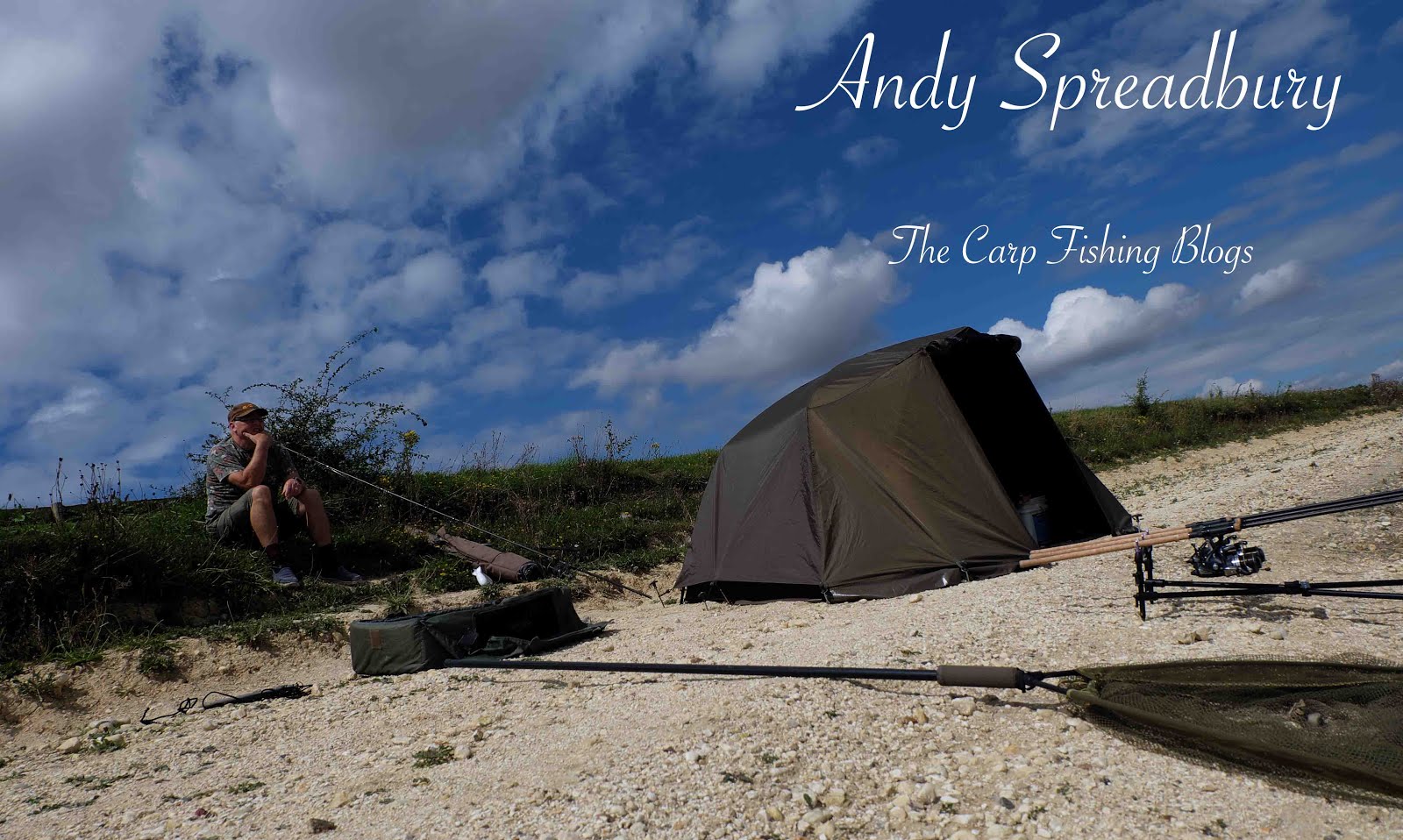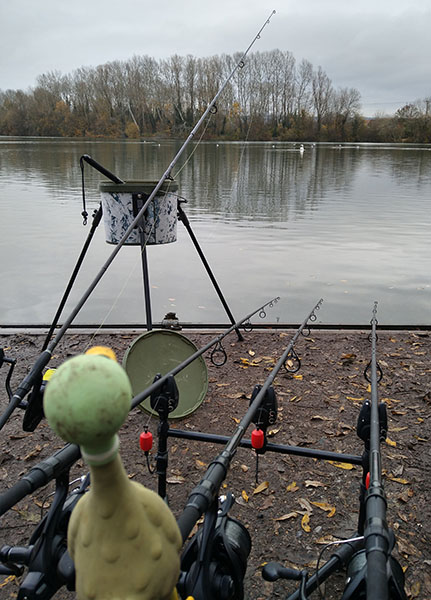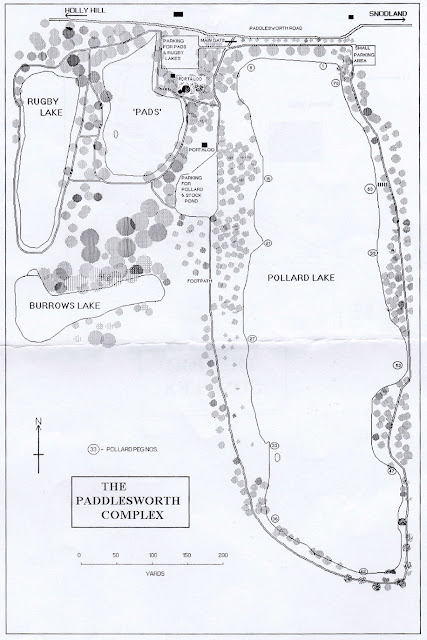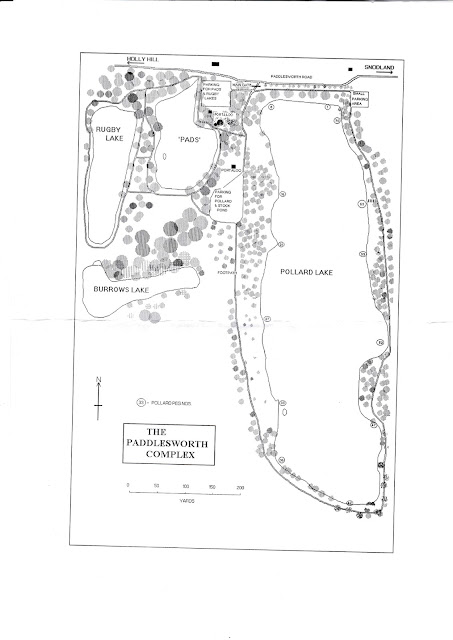28th.-30th.November 2019
Paddlesworth, Pollard, Peg 30
12.50All baits are out; some spodding completed (although there is still some to do. I’m just having a break for something to eat).
Two baits are on the usual mark whilst the rh rod is cast speculatively towards ‘The Brambles’ opposite. I’ve seen a couple of ‘shows’ in front of P31 and it makes sense to put a bait over there although I have introduced no spod mix over it. I’m hoping to pick up an opportunist fish rather than set my traps to a specific plan.
I have become more and more convinced that feeding is the key to catching carp on Pollard and I think the principles I have established for here would be equally successful on other waters of my acquaintance. Not all of them however because I think only on those which share the same characteristics as Pollard, will it work.
Pollard is in relative terms a ‘barren’ water. By that I don’t mean it doesn’t hold any of the creatures, organisms, flora, and fauna that sustain populations of carp. Indeed, there is weed in which reside Zebra Mussels and a host of insect larvae which can be seen hatching during warm, sunny evenings. No, what I mean is that for the most part, the bottom is relatively clean and the carp must travel significant distances in order to graze feeding-grounds. This is why beds of bait are so successful, they provide concentrations of food where the strategic placement of hook-baits on simple rigs is readily accepted. I can think of other similarly ‘barren’ waters which share these same characteristics.
Not so, rich, weedy waters, where there is relatively significant amounts of weed. The carp are more or less surrounded by food of all kinds and they don’t need to travel far (if at all) to find something to eat. Consequently, they do not share the roaming habits of their ‘barren’ water cousins and don’t need to move about as much. Here, a carefully placed pva bag of goodies is as likely to succeed as anything.
Just a theory…
No such luck...
13.35
Spodding has been extremely problematic (as it always is down here) today. Coots, Seagulls, and a lone swan are all competing to get at the feed coming out of the spod and I am convinced barely half of it is going down the throats of the carp rather than the birdlife diving on it. The little buggers are on it as soon as the spod hits the water; they’re diving on it within seconds and the swan is ‘up-ending’ on it before it sinks out of sight. I have to continually keep stopping and allow them to disperse - then try to get a couple of spods out before they’re back poaching it again! They are a flamin’ nightmare!
13.50
I can’t believe there’s not another angler in sight; where is everybody? Do they know something I don’t? Is it that nothing’s been out for a while? I’ve certainly seen enough already to suggest fish are moving nearby. I just need a decent enough amount of feed to get down past these bloody birds!
14.30
At last I feel I’ve got enough spod mix out there despite the birds. This swan has been pestering me all day, coming right into the bank between the rod-tips, picking up the lines to grub about for something on the bottom. No amount of violent behaviour on my part has managed to deter it! I’ve thrown stones at it, whacked it with my landing-net, and even given it a clout with my spod rod… No, it’s been obsessed with tormenting the life out of me!
Without any shadow of a doubt it is the thick-est, stupid-est, most brain-dead swan I have ever had the misfortune of sharing the lake with (and I’ve encountered a few dim-witted swans in my time!)
16.45
It’s raining. The weather app doesn’t give it stopping until about midnight so things are going to be decidedly damp for the next few hours. Only thing to do is sit it out until then - by which time I would hope to be asleep anyway.
My ‘Trakker’ bivvy has served me very well for the past few years and has not let me down, however I’m minded that bivvies have improved considerably over the years and the market has become much more competitive to the degree that well-designed, well-constructed, reasonably-priced products are far more available than they once were.
Tonight’s rain reminds me that the only design really worth considering is the ‘Pram Hood’ type (which my Trakker is not). It’s got a sloping front, which, when the rain falls vertically, soaks the porch and groundsheet if the door is not zipped down. The ‘Pram Hood’ of course hangs over the bivvy door and prevents such a situation in all but the specific condition of when rain blows right in.
I have lately become a fan of the ‘Sonik’ brand. I think their rods which I bought recently have been such good value for money that I have been looking at their other products, in particular bivvies.
They do one called an AXS (Access) which is of the aforementioned configuration priced at £270 which includes side and rear ventilation screens, a door, and a 10,000 thingy-whatsit hydrostatic head material (basically, that means it’s waterproof).
I find it astonishing that carp anglers are willing to pay between £400 and £600 for a bivvy, merely because it bears the Nash, Fox, Aquatex, or whatever brand. Fine if you are single and have no financial responsibilities and have no family members to whom you have to justify such purchases, but a complete no-no if you do!
20.00
Still raining… unfortunately, the wind has turned and it is now blowing in through the door which I have had to zip down. Ugh! Horrible!
21.15
I’ve heard a couple of fish jump, one of which was certainly a Top End Shoal member, up to the right.
There is every indication fish are on the move but the recent mild temperatures may well have brought them up in the water. That may be why they are ‘showing’ but not necessarily feeding, on the bottom. The weather app shows 8º going down to 5º by 5.00 a.m. so it’s not that mild! Perhaps this will be enough to persuade them to go down and feed? Wind Northerly, force 6-8.
I have been doing some work on ‘Spreadbury’s Law’ - which states that the biggest fish in the lake is double the average size of fish caught. Using a spreadsheet I have been calculating Mean and Standard Deviation.
(What the hell does that mean!?)
In a ‘Normal’ bell-shaped distribution curve (on a chart) the Mean (or Average) size of fish occurs at the top of the curve:
I'm commenting on this more to illustrate my mindset - than making a serious attempt at getting carp anglers to become Maths nerds!
Fish to the left of the Mean are smaller than average. Fish to the right of the Mean are bigger than average. There are a relatively small number of small fish, and a small number of big fish (which is reflected in actual catch data).
Standard Deviation is an indicator of how far from the Mean (or average) a fish is in relation to the general population of fish in the lake. It turns out that 1 x SD either side of the Mean accounts for about 68% of all the sizes of the fish in the lake; 2 x SDs 95% of all sizes, and 3 x SDs almost 100% of every potential size of carp. Three Standard Deviations can be used as an indicator in a Statistical Analysis of the maximum size of carp you are likely to catch and is a far better indicator than merely doubling the average and this is the ‘rule’ I have now adopted for ‘Spreadbury’s Law’.
Calculating Mean and Standard Deviation is well beyond the scope of these jottings (although you can work out the average size (or Mean) of the fish you catch by adding up all the weights and then dividing by the number of fish to which this applies). If you are acquainted with Spreadsheets it is easier to get them to do the calculations for you although you will require spreadsheet knowledge and some knowledge of selecting the correct Formulae to be entered in each ‘Cell’.
Amazing how the mind wanders - and what you get to thinking about while you are lying in the bivvy waiting for a take!…
Friday, 29th.November 2019
07.30Awoke to a sunlit dawn, the rain of last night having moved away.
Spodding this morning is once again a pain in the rear end… as soon as the spod is hitting the water, half-a-dozen Coots are diving on the feed and eating it before a carp has a chance to even get a sniff of it! It’s a real problem and I confess I have no answer to it at present other than waiting for them to move off elsewhere and ‘sneaking’ a cast while they’re not about. Two casts however and they’re back!
I don’t know what the solution is; at the moment I’m feeding the birds rather than the carp!
09.00
Nothing moving on the lake at all; it’s as dead as the proverbial… now I know why there’s no-one here - it’s just not fishing at the moment.
The gang of Coots are just sitting out there, waiting for me to start spodding. Seems like I could wait all day for them to clear off. Either I attempt to get something over the rods or I don’t bother at all.
09.20
Sometimes you just know you are fishing well. Baiting is accurate and consistent, the baits are (eventually) landing exactly where you want them to, and you are doing everything you possibly can to get a bite. You feel you can not do more.
Winter fishing is very much like that - even though the fish may not be co-operating, something will at some point during the long winter months, sooner or later, turn up. Provided you keep fishing well, that is as much as you can do. Winter Carp Fishing is an Act of Faith as much as an act of proficiency.
10.00
Just taken the water temperature ten yards out and it’s still ten degrees - by no means winter values. Pollard it seems, being a deep lake, takes longer to cool down than shallower lakes so I suppose you could assume the chances of a fish are better? It’s when it gets to six or seven degrees that winter can really be said to have taken hold.
10.15
I’m getting ‘liners’ on the rh rod; the trouble is, there are so many Coots out there (and they are diving down) that it’s a job to know whether it’s them or carp!
11.20
All this spodding has focussed the mind somewhat on Spods and Spombs and I have been trying as many different types as my pocket currently allows. Since I am not sponsored by anyone I have to pay for all my tackle so financial restrictions prevent an extensive trial across a broad range of products.
The usual suspects - ‘Spomb’ and Fox Spombs both work but I find with both brands they don’t always open and this can be a real pain. I’ve currently got two different Spods - a Korda ‘Skyliner’ and an Avid ‘Air Range’. Of the two, the Korda is longer and thinner and is more difficult to load than the shorter and fatter Avid. Both cast equally as well, the downside to the Avid being that it is a devil to wind back in as with ‘its mouth open’ it ‘digs in’ to the water. The Korda spod however skips across the water’s surface much better. The problem with both spods and indeed the spombs as well is their payload capacity, particularly the spombs. The large sizes are too big and the medium sizes too small; what is wanted is a size in-between. The rod I am using is a 4lbs. TC Spod Rod (‘Advanta’ I think) and like as not, going up to 4.5lbs. TC would cast the larger spombs better. 4lbs. is under-powered for the big spombs and a payload which amounts to something in the order of six ounces or so. I shall continue however to look for the ideal product and will report further on trials.
12.45
A fish jumped in front of P31 over silkweed. Ideally, a pop-up on a long boom seems appropriate - but it’s something I should certainly bear in mind for the future. Never thought of fishing P31 but the fish are definitely there.
Recast the rh rod to the right of the telegraph pole; this, on the assumption there might be fish to the right of my peg.
13.45
I took the opportunity while it was quiet out there to get a few spods of bait out. Having done so I put the spodding gear to one side and got out my notebook to make some comments.
Then the lh rod pulled tight, took some line, and then stopped… I picked the rod up anyway and lifted - into a fish! Everything felt solid as whatever was on the end ‘dug its toes in’ and didn’t budge an inch! Unlike most carp which when they are initially hooked present a solid, yet yielding resistance, this one hugged the bottom and slowly chugged off! I’d got a real ‘whacker’ on here!
There then followed fifteen minutes of epic battle during which I was convinced I was attached to a very big fish! Inch by grudging inch I got it nearer and nearer the net, fully expecting it to be a thirty-pounder and when I finally got it within the folds I thought it might just about make it.
a stonking fish nonetheless!
Inevitably however it fell short by some way - but still registered a very creditable 27:10, a stonking fish that fought as hard as any I have caught recently.
Yippee! Another belting carp from Polly’!
16.30
Nightfall. I’ve managed to do a bit of spodding and I think the Coots are having trouble seeing the feed falling through the water column. They might be just seeing the boilies but the Hemp definitely not.
17.00
Just finished spodding. Everything is now out there and this will be a good test of the old chestnut “they won’t want as much food in the colder water” theory. We are always told not to put too much bait out in the winter because their metabolism slows down in the cold, blah de blah de blah! Not on here according to Ryan.
We shall see if he is right.
21.20
Awoken by a blinding run to the left-hand rod!…
As I stepped out of the bivvy (having got my ‘crocs’ on the wrong feet again) I felt the ice and frost crackling underfoot! The line was running out smoothly and when I lifted into the fish I thought “Oh; only a small one”; and when it came in rather easily to the bank my thoughts were that it may not even make a ‘double’. Wrong! Big mistake! The next fifteen minutes were a tug-o-war between me and the fish of which I was the eventual winner. Twenty-five pounds eight ounces. The weighing and photographing were more than hastily completed as it was a job separating ice, fish, frost, unhooking-mat and retainer sling from one another!
Job done!
23.00
Just tested the bite alarms - all three frozen solid and non-functional!
Saturday, 30th.November 2019
08.00Paralysingly cold night during which I lay awake wondering whether I was going to miss a take because the alarms weren’t working! There was such a heavy dew early in the evening that this froze to ice and solidified the rollers in the alarm heads, hence, no amount of pulling the lines would make the rollers budge! Even now they are still not working and I’m wondering whether the intense cold has knocked the batteries for six?
11.25
At last the rh bite alarm has come back to life - not surprising it has taken such a long time, there’s still ice lying around on the bankside! The wind is from the North and is bitingly cold and the bivvy is taking forever to dry out. No sign of life on the lake at all although it seems as if the entire bird population of the whole of the South East of England has descended on the place!
13.00
Time to get off home…










Comments
Post a Comment